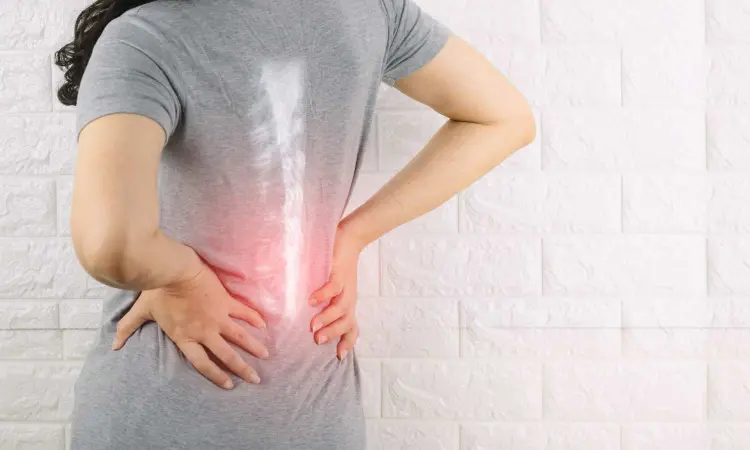- Home
- Medical news & Guidelines
- Anesthesiology
- Cardiology and CTVS
- Critical Care
- Dentistry
- Dermatology
- Diabetes and Endocrinology
- ENT
- Gastroenterology
- Medicine
- Nephrology
- Neurology
- Obstretics-Gynaecology
- Oncology
- Ophthalmology
- Orthopaedics
- Pediatrics-Neonatology
- Psychiatry
- Pulmonology
- Radiology
- Surgery
- Urology
- Laboratory Medicine
- Diet
- Nursing
- Paramedical
- Physiotherapy
- Health news
- Fact Check
- Bone Health Fact Check
- Brain Health Fact Check
- Cancer Related Fact Check
- Child Care Fact Check
- Dental and oral health fact check
- Diabetes and metabolic health fact check
- Diet and Nutrition Fact Check
- Eye and ENT Care Fact Check
- Fitness fact check
- Gut health fact check
- Heart health fact check
- Kidney health fact check
- Medical education fact check
- Men's health fact check
- Respiratory fact check
- Skin and hair care fact check
- Vaccine and Immunization fact check
- Women's health fact check
- AYUSH
- State News
- Andaman and Nicobar Islands
- Andhra Pradesh
- Arunachal Pradesh
- Assam
- Bihar
- Chandigarh
- Chattisgarh
- Dadra and Nagar Haveli
- Daman and Diu
- Delhi
- Goa
- Gujarat
- Haryana
- Himachal Pradesh
- Jammu & Kashmir
- Jharkhand
- Karnataka
- Kerala
- Ladakh
- Lakshadweep
- Madhya Pradesh
- Maharashtra
- Manipur
- Meghalaya
- Mizoram
- Nagaland
- Odisha
- Puducherry
- Punjab
- Rajasthan
- Sikkim
- Tamil Nadu
- Telangana
- Tripura
- Uttar Pradesh
- Uttrakhand
- West Bengal
- Medical Education
- Industry
Low BMD reduction closely associated with significantly elevated risk of stroke: Study

A new study published in the recent issue of Frontiers in Neurology journal showed that a markedly elevated risk of stroke is linked to a reduced bone mineral density (BMD). In comparison to men, the findings suggest that women are in greater danger.
In the globe, stroke ranks as the 2nd most common cause of mortality and a major contributor to long-term impairment. Treatment for a stroke comes with a huge financial burden. Every year, there are around 0.7 million new stroke cases in the US and 4 million in China. To reduce the risk of stroke and lessen the burden of the illness, it is crucial to identify the underlying risk factors and put effective preventative methods into place.
Particularly in women, low bone mineral density (BMD) is a serious public health issue. People who have had a stroke are known to be more susceptible to hip fractures or poor bone mineral density. The relationship between BMD and stroke risk is still debatable, though. Thereby, to consolidate the existing information, Peng Zhao and team performed a systematic review and meta-analysis in the current study.
Finding out if low BMD is linked to a higher risk of stroke and assessing the relationship between the incidence of stroke and the standard deviation (SD) decrease in BMD were the main goals. In order to find cohort studies with follow-up that documented the impact of a decline in BMD or low BMD status on the risk of any kind of stroke, this research conducted a thorough search of Embase, Medline, and the Cochrane Database of Systematic The reviews were until January 2025 and random-effects models were used for pooled analyses.
Nearly, 13 studies including a total of 1,46,758 participants were considered in this analysis. An elevated risk of stroke was linked to a 1 SD decrease in BMD. The subgroup analysis revealed that incident stroke was linked to a per SD decrease in BMD in females but not in males. Males and the individuals with osteoporosis or osteopenia were more likely to get an incident stroke. Sensitivity analysis demonstrated the stability of the findings.
Overall, a significant increased risk of stroke is linked to a decrease in bone mineral density. When compared to men, women are in greater danger. An incident stroke is more likely to occur in those who have osteoporosis or osteopenia. The results emphasize how closely bone health and stroke are related.
Source:
Zhao, P., & Sun, H. (2025). Association between bone mineral density and stroke: a meta-analysis. Frontiers in Neurology, 16. https://doi.org/10.3389/fneur.2025.1561559
Neuroscience Masters graduate
Jacinthlyn Sylvia, a Neuroscience Master's graduate from Chennai has worked extensively in deciphering the neurobiology of cognition and motor control in aging. She also has spread-out exposure to Neurosurgery from her Bachelor’s. She is currently involved in active Neuro-Oncology research. She is an upcoming neuroscientist with a fiery passion for writing. Her news cover at Medical Dialogues feature recent discoveries and updates from the healthcare and biomedical research fields. She can be reached at editorial@medicaldialogues.in
Dr Kamal Kant Kohli-MBBS, DTCD- a chest specialist with more than 30 years of practice and a flair for writing clinical articles, Dr Kamal Kant Kohli joined Medical Dialogues as a Chief Editor of Medical News. Besides writing articles, as an editor, he proofreads and verifies all the medical content published on Medical Dialogues including those coming from journals, studies,medical conferences,guidelines etc. Email: drkohli@medicaldialogues.in. Contact no. 011-43720751


